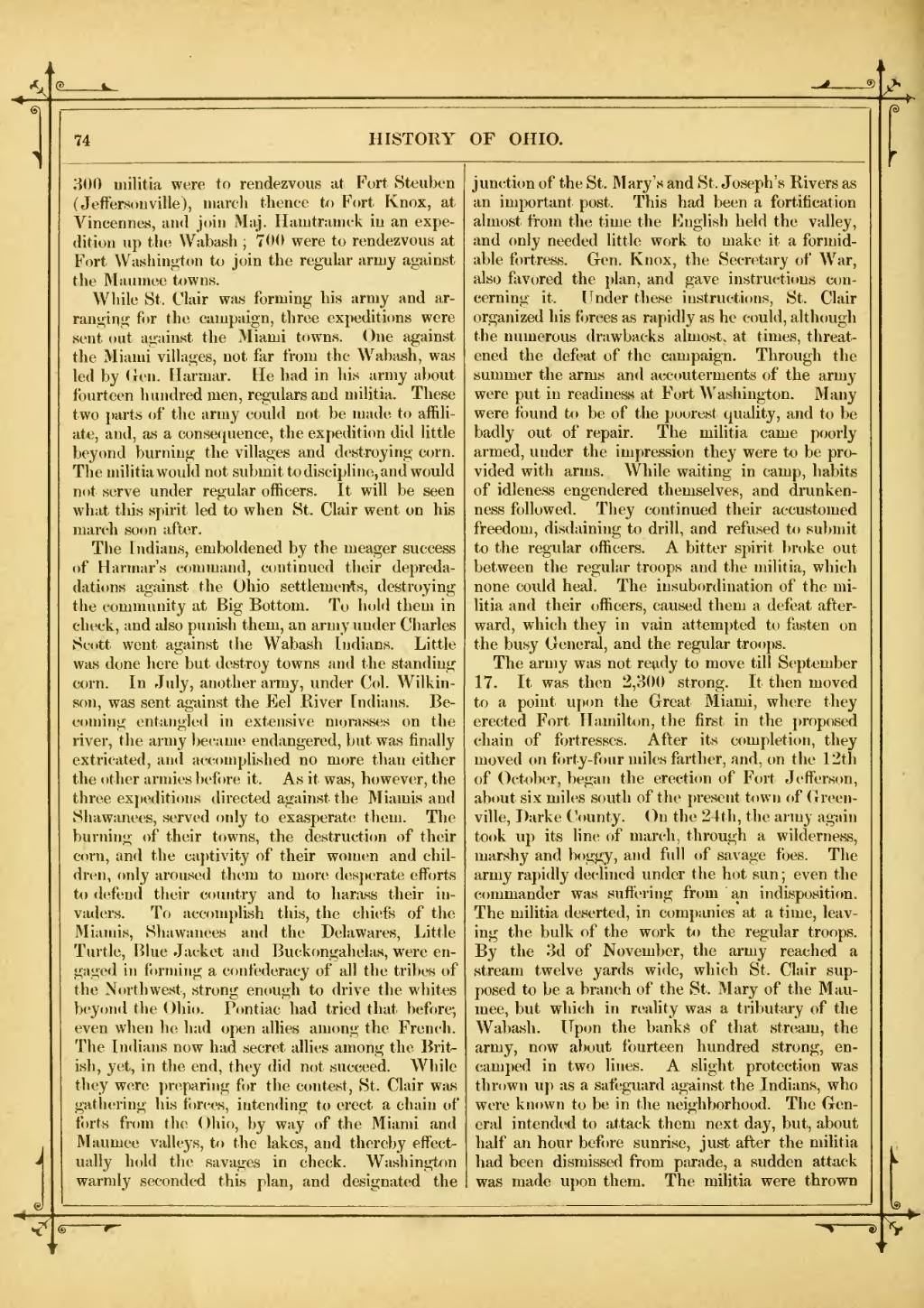liL
��74
��HISTORY OF OHIO.
��300 militia were to rendezvous at Fort Steuben ( Jefferson ville), march thence to Fort Knox, at Vincennes, and join Maj. Hamtramck in an expe- dition up the Wabash ; 700 were to rendezvous at Fort Washington to join the regular army against the Maumee towns.
While St. Clair was forming his army and ar- ranging for the campaign, three expeditions were sent out against the Miami towns. One against the Miami villages, not far from the Wabash, was led by Gen. Harmar. He had in his army about fourteen hundred men, regulars and militia. These two parts of the army could not be made to affili- ate, and, as a consequence, the expedition did little beyond burning the villages and destroying corn. The militia would not submit to discipline, and would not serve under regular officers. It will be seen what this spirit led to when St. Clair went on his march soon after.
The Indians, emboldened by the meager success of Harmar's command, continued their depreda- dations against the Ohio settlements, destroying the comnmnity at Big Bottom. To hold them in check, and also punish them, an army under Charles Scott went against the Wabash Indians. Little was done here but destroy towns and the standing corn. In July, another army, under Col. Wilkin- son, was sent against the Eel River Indians. Be- coming entangled in extensive morasses on the river, the army became endangered, but was finally extricated, and accomplished no more than either the other armies before it. As it was, however, the three expeditions directed against the Miamis and Shawanees, served only to exasperate them. The burning of their towns, the destruction of their corn, and the captivity of their women and chil- dren, only aroused them to more desperate efforts to defend their country and to harass their in- vaders. To accomplish this, the chiefs of the Miamis, Shawanees and the Delawares, Little Turtle, Blue Jacket and Buckongahelas, were en- gaged in forming a confederacy of all the tribes of the Northwest, strong enough to drive the whites beyond the Ohio. Pontiac had tried that before- even when he had open allies among the French. The Indians now had secret allies among the Brit- ish, yet, in the end, they did not succeed. While they were preparing for the contest, St. Clair was gathering his forces, intending to erect a chain of forts from the Ohio, by way of the Miami and Maumee valleys, to the lakes, and thereby effect- ually hold the savages in check. Washington warmly seconded this plan, and designated the
��junction of the St. Mary's and St. Joseph's Rivers as an important post. This had been a fortification almost from the time the English held the valley, and only needed little work to make it a formid- able fortress. Gen. Knox, the Secretary of War, also favored the plan, and gave instructions con- cerning it. Under these instructions, St. Clair organized his forces as rapidly as he could, although the numerous drawbacks almost, at times, threat- ened the defeat of the campaign. Through the summer the arms and accouterments of the army were put in readiness at Fort Washington. Many were found to be of the poorest quality, and to be badly out of repair. The militia came poorly armed, under the impression they were to be pro- vided with arms. While waiting in camp, habits of idleness engendered themselves, and drunken- ness followed. They continued their accustomed freedom, disdaining to drill, and refused to submit to the regular officers. A bitter spirit broke out between the regular troops and the militia, which none could heal. The insubordination of the mi- litia and their officers, caused them a defeat after- ward, which they in vain attempted to fasten on the busy General, and the regular troops.
The army was not re^dy to move till September 17. It was then 2,300 strong. It then moved to a point upon the Great Miami, where they erected Fort Hamilton, the first in the proposed chain of fortresses. After its completion, they moved on forty -four miles farther, and, on the 12th of October, began the erection of Fort Jefferson, about six miles south of the present town of Green- ville, Darke County. On the 24th, the army again took up its line of march, through a wilderness, marshy and boggy, and full of savage foes. The army rapidly declined under the hot sun ; even the commander was suffering from ' an indisposition. The militia deserted, in companies at a time, leav- ing the bulk of the work to the regular troops. By the 3d of November, the army reached a stream twelve yards wide, which St. Clair sup- posed to be a branch of the St. Mary of the Mau- mee, but which in reality was a tributary of the Wabash. Upon the banks of that stream, the army, now about fourteen hundred strong, en- camped in two lines. A slight protection was thrown up as a safeguard against the Indians, who were known to be in the neighborhood. The Gen- eral intended to attack them next day, but, about half an hour before sunrise, just after the militia had been dismissed from parade, a sudden attack was made upon them. The militia were thrown
��y:
�� �
